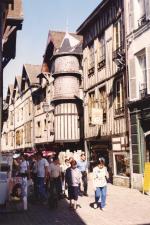|
Topcon MT-2 |
Manufactured or assembled in Japan from (Circa) 1985 to (Before) 2005.
Index of rarity in France: Rare (among non-specialized garage sales)
Inventory number: 14168
See the complete technical specifications
Chronology of cameras Topcon
Nowadays, Topcon no longer offers consumer photographic equipment, but continues its activities in the medical field and laser telemetry.
The MT-1 and MT-2 cameras were intended for ophthalmologists for examinations of the fundus of the eye. They were designed to be mounted on a retinal camera / angiography device called TRC-50X, but could also be used with other medical devices in the TRC series. A user manual from 2005 suggests another film camera (Topcon MT-10) for use with the TRC-50X. Later, adaptations for the use of digital cameras were also proposed.
The bayonet mount of these models is specific to their attachment to the equipment.
The small lever located below the MT-1 or MT-2 logo is used for manual triggering.
When used with the TRC equipment, film transport and shutter winding are handled by the motor located under the base of the camera. It is powered by the medical equipment. In addition to the power on/off button and a two or three-position selector: S, 1, and 2, which allows choosing between single-shot or burst modes (1 frame/s or 2 frames/s), there is a red indicator light indicating film advancement and the end of the roll.
The view counter, very discreet, is located on the back under the axis of the winding lever. This positioning makes it easy to observe when the camera is in working position on the medical observation equipment.
On the top cover, there is a winding lever and a specific prism viewfinder device that can be quickly removed by pressing two buttons simultaneously. Once the viewfinder prism is removed, you can access a particular focusing screen with a truncated circular portion at the top and bottom, as well as a small rectangle on the left side of the view. The circular portion contains a double crosshair reticle. To facilitate focusing, the viewfinder eyepiece can be adjusted between -4 diopters and +2 diopters. Topcon optionally offered a Relay Magnifying Viewer with two eyepieces that facilitated the work of practitioners for certain types of examinations. Finally, on the left side, there is a rewind button that also, when pulled vertically, opens the back for loading the 35mm film.
Near the bayonet mount, there is a flash sync socket. It is likely unnecessary.
The shutter speed is fixed at 1/60. The medical device adjusted the illumination of the fundus of the eye according to the film sensitivity used (100 or 400 ASA). Certain types of examinations (angiography) required the use of specific filters chosen on the angiography device to highlight the blood vessels of the fundus of the eye. The patient would receive a tracer intravenously beforehand.
The practitioner had the option to write information about the patient on a small piece of plastic called the Data Plate, which was photographed along with the fundus of the eye and appeared in a small rectangle on the left side of the image. The doctor could also use the same area of the photograph to write, for example, a 12-digit view number in two rows, which could be addressed via external equipment (ID mode). The resulting image would be recorded on the film within a horizontally truncated circle at the top and bottom (26mm in its larger diameter and 22mm in height). A very small square-shaped notch (about one millimeter in size), present here at 1 o'clock, is the signature of a photo taken with Topcon equipment. Canon cameras left an arc-shaped mark, while Olympus cameras left a triangle-shaped mark.








